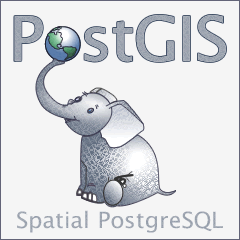Manuale di PostGIS 3.6.0dev
DEV (Wed 23 Oct 2024 07:18:55 AM UTC rev. 1dca456 )
Abstract
PostGIS è un'estensione del database object-relational PostgreSQL che consente l'archiviazione di oggetti GIS (Geographic Information Systems). PostGIS comprende il supporto per gli indici spaziali R-Tree basati su GiST, e funzioni per l'analisi e l'elaborazione di oggetti GIS.


Questo è il manuale per la versione 3.6.0dev
 Questa opera è rilasciata con una licenza Creative Commons Attribution-Share Alike 3.0 License. Siete liberi di utilizzare questo materiale come volete, ma vi chiediamo di citare il progetto PostGIS come fonte e, ove possibile, di inserire un link a http://postgis.net.
Questa opera è rilasciata con una licenza Creative Commons Attribution-Share Alike 3.0 License. Siete liberi di utilizzare questo materiale come volete, ma vi chiediamo di citare il progetto PostGIS come fonte e, ove possibile, di inserire un link a http://postgis.net.
Table of Contents
- 1. Introduzione
- 2. Installazione PostGIS
- 3. Amministrazione di PostGIS
- 4. Data Management
- 5. Spatial Queries
- 6. Suggerimenti per le prestazioni
-
7. Guida a PostGIS
- 7.1. Tipi di dati PostGIS Geometria/Geografia/Box
- 7.2. Funzioni di gestione delle tabelle
- 7.3. Costruttori geometrici.
- 7.4. Accessori alla geometria
- 7.5. Editori di geometria
- 7.6. Geometry Validation
- 7.7. Spatial Reference System Functions
- 7.8. Ingresso geometria
- 7.9. Geometry Output
- 7.10. Operatori
- 7.11. Relazioni Spaziali
- 7.12. Measurement Functions
- 7.13. Overlay Functions
- 7.14. Geometry Processing
- 7.15. Coverages
- 7.16. Affine Transformations
- 7.17. Clustering Functions
- 7.18. Bounding Box Functions
- 7.19. Sistemi di riferimento lineare
- 7.20. Trajectory Functions
- 7.21. Version Functions
- 7.22. Grand Unified Custom Variables (GUCs)
- 7.23. Troubleshooting Functions
- 8. SFCGAL Functions Reference
-
9. Topologia
- 9.1. Tipi di dato topologici
- 9.2. Domini Topologici
- 9.3. Gestione di topologie e TopoGeometry
- 9.4. Topology Statistics Management
- 9.5. Topology Constructors
- 9.6. Topology Editors
- 9.7. Topology Accessors
- 9.8. Topology Processing
- 9.9. TopoGeometry Constructors
- 9.10. TopoGeometry Editors
- 9.11. TopoGeometry Accessors
- 9.12. TopoGeometry Outputs
- 9.13. Topology Spatial Relationships
- 9.14. Importing and exporting Topologies
- 10. Dati raster: gestione, interrogazione e applicazioni
-
11. Riferimento raster
- 11.1. Supporto raster Tipi di dati
- 11.2. Gestione dei raster
- 11.3. Raster Constructors
- 11.4. Accessori raster
- 11.5. Raster Band Accessors
- 11.6. Raster Pixel Accessors and Setters
- 11.7. Raster Editors
- 11.8. Raster Band Editors
- 11.9. Raster Band Statistics and Analytics
- 11.10. Raster Inputs
- 11.11. Raster Outputs
- 11.12. Raster Processing: Map Algebra
- 11.13. Built-in Map Algebra Callback Functions
- 11.14. Raster Processing: DEM (Elevation)
- 11.15. Raster Processing: Raster to Geometry
- 11.16. Raster Operators
- 11.17. Raster and Raster Band Spatial Relationships
- 11.18. Raster Tips
- 12. Extra di PostGIS
-
13. Indice delle funzioni speciali di PostGIS
- 13.1. Funzioni Aggregate PostGIS
- 13.2. Funzioni finestra PostGIS
- 13.3. Funzioni PostGIS compatibili con SQL-MM
- 13.4. Funzioni di supporto alla geografia PostGIS
- 13.5. Funzioni di supporto per i raster di PostGIS
- 13.6. Funzioni di dump Raster / Geometria / Geografia
- 13.7. Funzioni del box PostGIS
- 13.8. Funzioni PostGIS che supportano il 3D
- 13.9. Funzioni di supporto per la geometria curva di PostGIS
- 13.10. Funzioni di supporto per superfici poliedriche PostGIS
- 13.11. Matrice di supporto alle funzioni PostGIS
- 13.12. Funzioni PostGIS nuove, migliorate o modificate
- 14. Segnalare Problemi
- A. Appendix